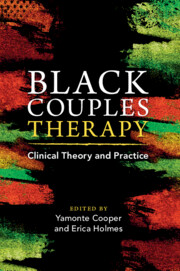Book contents
- Black Couples Therapy
- Black Couples Therapy
- Copyright page
- Contents
- Figures
- Tables
- Contributors
- Foreword
- Acknowledgments
- Introduction
- Part I Race, Racism, and Identity
- Part II Foundations for Healthy Coupling
- Part III Adapting Major Therapeutic Approaches for Work with African American Couples
- Part IV Sex and Intimacy
- Chapter 11 Sexual Intimacy in Black Heterosexual Couple Relationships: Challenges and Opportunities toward Relational Intimacy
- Chapter 12 Intimacy, Desire, and Sex in the African American Relationships
- Chapter 13 Wearing a Mask in Love: Implications for Covering and Infidelity in Black Relationships
- Part V Special Topics
- Index
- References
Chapter 12 - Intimacy, Desire, and Sex in the African American Relationships
from Part IV - Sex and Intimacy
Published online by Cambridge University Press: 27 July 2023
- Black Couples Therapy
- Black Couples Therapy
- Copyright page
- Contents
- Figures
- Tables
- Contributors
- Foreword
- Acknowledgments
- Introduction
- Part I Race, Racism, and Identity
- Part II Foundations for Healthy Coupling
- Part III Adapting Major Therapeutic Approaches for Work with African American Couples
- Part IV Sex and Intimacy
- Chapter 11 Sexual Intimacy in Black Heterosexual Couple Relationships: Challenges and Opportunities toward Relational Intimacy
- Chapter 12 Intimacy, Desire, and Sex in the African American Relationships
- Chapter 13 Wearing a Mask in Love: Implications for Covering and Infidelity in Black Relationships
- Part V Special Topics
- Index
- References
Summary
Intimacy, sex, and desire are important elements to personal and relational well-being and are some of the top reasons couples seek therapy. For Black couples, there is a unique challenge that can hamper the development of these elements given the historical backdrop of oppression that contributes to significant stressors on these couples. Helping Black couples to understand how they make meaning of sex, intimacy, and interactions with their partner, while maintaining a clear sense of self in the context of their physical and emotional closeness, has been positively associated with sexual desire, intimacy, and couple satisfaction. This chapter looks at the role of differentiation, the impact it has on a Black couple’s intimate life, and how clinicians can help facilitate the process of increasing the couple’s levels of differentiation, thus breathing life into the relationship.
- Type
- Chapter
- Information
- Black Couples TherapyClinical Theory and Practice, pp. 273 - 292Publisher: Cambridge University PressPrint publication year: 2023

